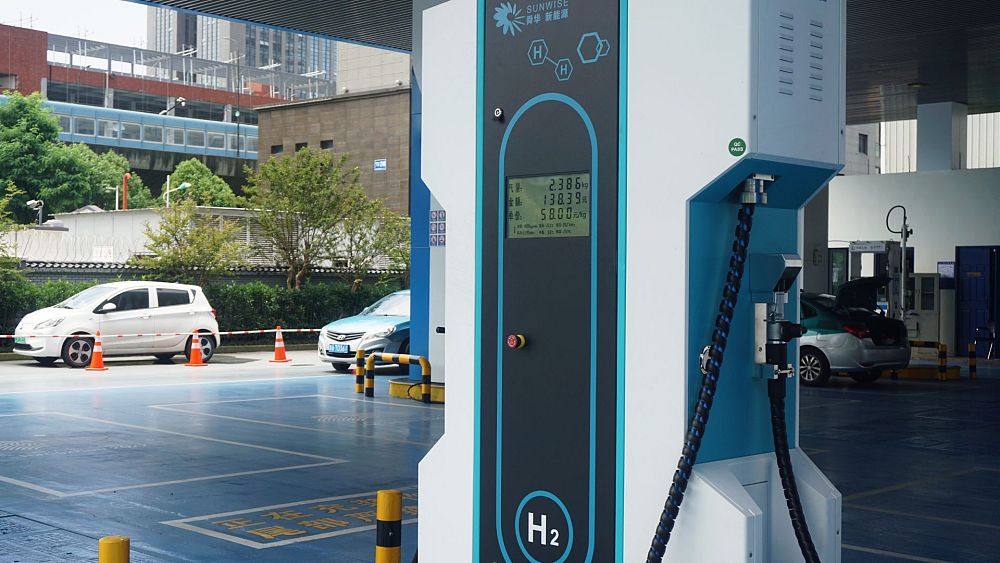What is ‘white hydrogen’ and could it be a fuel of the future?

Hydrogen has been touted as the ‘fuel of the future’. It only emits heat and water when it burns, making it an appealing alternative to fossil fuels.
But the majority of hydrogen production currently relies on gas or coal, in processes that emit a lot of CO2.
‘Green’ hydrogen, which is made using renewable energy, offers a promising – but expensive – alternative. So what if there was a way to cut out these production processes altogether?
Earth holds vast supplies of natural hydrogen that could be extracted from the ground.
A huge discovery of this so-called ‘white’ hydrogen in France earlier this year sparked excitement that it could become a clean, cheap and renewable energy source.
Switzerland soon joined the search, finding natural hydrogen in the Graubünden canton in spring. In summer, the country began probing rocks in Valais for further deposits.
Could white hydrogen hold the key to safe and clean energy, and why is it only just being explored?
What is white hydrogen?
Hydrogen is the most abundant chemical element on Earth and occurs naturally in everything from water to plants.
Until recently, however, significant quantities of hydrogen gas in its pure form were not thought to be present within the earth.
An accidental discovery was made in Mali in 2012. A borehole drilled for a well decades earlier was found to be emitting almost pure natural hydrogen.
Since then, geologists have increasingly been experimenting with extracting supplies of this natural gas – thought to form through water-mineral reactions – from beneath the earth’s surface.
Unlike fossil fuel stores, which take millions of years to form, natural or ‘white’ hydrogen is continuously replenished.
Is white hydrogen the future of safe and clean energy?
It isn’t yet clear exactly how white hydrogen deposits form, and whether they are commercially exploitable.
Startups and scientists are exploring this possibility – with some promising results.
“The earth has many locations where the right conditions co-exist to naturally produce and accumulate hydrogen, which can then be extracted for societal use,” Dr Michael Webber, a professor in energy resources at the University of Texas, Austin, USA, tells Euronews Green.
“The good news is that by letting the earth do the work for us, this source of hydrogen is likely much cleaner to produce than current methods of gasifying coal, reforming methane, or electrolysing water.”
Although most natural hydrogen is likely to be found in unreachable offshore locations, deposits have been discovered in Australia, eastern Europe, France, Oman, Spain and the US, as well as in Mali, West Africa.
In May, a large deposit of natural hydrogen was accidentally discovered in the Lorraine region of France. A research team from the University of Lorraine’s GeoRessources Lab, France’s National Centre for Scientific Research (CNRS) and energy producer La Française de l’Energie found it while testing methane levels in the soil.
They are currently drilling deeper to find out exactly how much hydrogen there is, but estimate that there could be around 46 million tonnes – the equivalent of more than half of the world’s current annual production of grey hydrogen – according to CNRS.
Meanwhile in northeast Spain, exploration company Helios Aragón says it has located a reservoir of over one million tonnes of hydrogen, which it aims to start drilling in 2024.
It shows promise as a cheap alternative to green hydrogen, which currently costs roughly €5 per kilogram. White hydrogen costs just €0.50 per kilogram, news and research outlet Science reports.
What are the problems with hydrogen energy?
White hydrogen may not be a silver bullet for the energy crisis, however.
Some scientists say the lack of data on hydrogen leaks and the potential harm they could cause is an issue for the emerging industry.
If hydrogen seeps into the atmosphere, it can reduce the concentration of molecules that destroy the greenhouse gases there, counteracting its environmental benefits.
With a lack of technology to monitor hydrogen leaks, this could be a major blind spot.
“As with other sources of hydrogen, [natural hydrogen] needs to be handled with care to reduce safety risks and avoid leaks,” says Dr Webber.
But it may not be as significant an environmental risk as some believe.
“Our research at UT Austin, which was presented [on Wednesday] at the ASME IMECE conference in New Orleans, concludes that the indirect global warming impact of fugitive hydrogen emissions is actually quite small compared to other life cycle greenhouse gas impacts, so the greenhouse risks from unwanted hydrogen leaks is minor.”
Leaks aren’t the only concern when transporting hydrogen, though. It takes up a lot of space in gas form and requires a temperature of -253°C to be liquified, which could be prohibitively expensive.
There is also a lack of pipelines and distribution systems for hydrogen. The fossil fuel industry hopes that it could eventually move through existing infrastructure, such as gas pipelines. However, scientists say that hydrogen can corrode metal pipes and lead to cracking.
Not only are hydrogen molecules much smaller and lighter than those in methane, making them harder to contain, but they are also far more explosive than natural gas – raising safety concerns.
These are some of the reasons heat pumps and battery powered EVs won out over hydrogen-based alternatives, according to Science.
The fuel could be better suited to heavy-duty vehicles which can’t easily use batteries, such as trucks, ships and planes, as well as the steel industry and chemical processes like fertiliser production.
Source: Euro News















